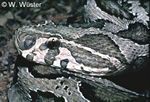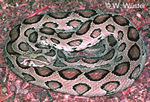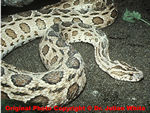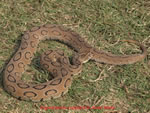|
Daboia russelii
|
![Daboia russelii (Russell's Viper) [ Original photo copyright © Dr Wolfgang Wuster ]](images/snakes/SNP00551.jpg)
|
|
Family: Viperidae
|
|
Subfamily: Viperinae
|
|
Genus: Daboia
|
|
Species: russelii
|
Common Names
Russell's Viper , Chain Viper , Tic Polonga
|
Local Names
Chandra Bora , Chitra , Daboia , Mandalatha Havu , Mandali , Ghonas , Koraile , Kannadi Viriyan , Raktha Pinjara , Katukarekula Poda , Thith Polonga , Kannadi Viriyan
|
Region
West Asia + Indian Sub-continent
|
Countries
Bangladesh, Bhutan, India, Nepal, Pakistan, Sri Lanka
|
|

|
|
|
|
Taxonomy and Biology
|
|
Adult Length: 1.00 m
|
General Shape
Medium in length, heavy and stout bodied, dorsoventrally flattened snake with a short tail. Can grow to a maximum of about 1.85 metres ( males larger than females ). Head is large, flat, bluntly pointed ( snout rounded and broad ), broadly triangular and distinct from neck with strongly keeled scales and large nostrils. Canthus is distinct. Eyes are medium to moderately large in size with vertically elliptical pupils. Dorsal scales are strongly keeled. Dorsal scale count usually ( 25 to 29 ) - ( 27 to 33 ) - ( 21 to 23 ).
|
Habitat
Lowland plains, open fields, hills and mountain foothills up to about 3000 metres (Indian subcontinent). More abundant in open lowland plains. Very common in scrub jungle and grasslands bordering agricultural plantations, but may be found in a wide variety of terrain particularly open, rocky, bushy or grassland regions.
|
Habits
Nocturnal and most active during early evening. Captures prey by ambush. If disturbed, it tends to hold its ground rather than flee, hisses loudly and assumes a striking position with a lateral S-shaped loop of the neck. If it strikes it does so with force inflicting a deep bite.
|
Prey
Feeds mainly on rodents, lizards, frogs and ground birds.
|
|
|
|
Venom
|
Average Venom Qty
130 to 250 mg ( dry weight ), U.S. Dept. Navy (1968) ( Ref : R000914 ).
130 to 250 mg ( dry weight ), Minton (1974) ( Ref : R000504 ).
|
General: Venom Neurotoxins
Presynaptic neurotoxins
|
General: Venom Myotoxins
Systemic myotoxins present (Sri Lanka)
|
General: Venom Procoagulants
Mixture of procoagulants
|
General: Venom Anticoagulants
Possibly present
|
General: Venom Haemorrhagins
Zinc metalloproteinase
|
General: Venom Nephrotoxins
Possibly present
|
General: Venom Cardiotoxins
Probably not present
|
General: Venom Necrotoxins
Possibly present
|
General: Venom Other
Unknown
|
|
|
|
Clinical Effects
|
General: Dangerousness
Severe envenoming likely, high lethality potential
|
|
General: Rate of Envenoming: >80%
|
|
General: Untreated Lethality Rate: 10-20%
|
General: Local Effects
Marked local effects; pain, severe swelling, bruising, blistering, necrosis
|
General: Local Necrosis
Uncommon but can be moderate to severe
|
General: General Systemic Effects
Variable non-specific effects which may include headache, nausea, vomiting, abdominal pain, diarrhoea, dizziness, collapse or convulsions
|
General: Neurotoxic Paralysis
Mild flaccid paralysis (ptosis & ophthalmoplegia) possible.
|
General: Myotoxicity
No case reports in Indian subcontinent for this species, but in Sri Lanka can cause significant systemic myolysis with myoglobinuria.
|
General: Coagulopathy & Haemorrhages
Very common, coagulopathy + haemorrhagins causing bleeding is major clinical effect
|
General: Renal Damage
Common, renal failure is major clinical effect (less common in Sri Lanka)
|
General: Cardiotoxicity
Rare, usually secondary
|
General: Other
Shock secondary to fluid shifts due to local tissue injury is possible in severe cases. Anterior pituitary haemorrhage with panhypopituitarism can occur.
|
|
|
|
First Aid
|
|
Description: First aid for bites by Viperid snakes likely to cause significant local injury at the bite site (see listing in Comments section).
|
Details
1. After ensuring the patient and onlookers have moved out of range of further strikes by the snake, the bitten person should be reassured and persuaded to lie down and remain still. Many will be terrified, fearing sudden death and, in this mood, they may behave irrationally or even hysterically. The basis for reassurance is the fact that many venomous bites do not result in envenoming, the relatively slow progression to severe envenoming (hours following elapid bites, days following viper bites) and the effectiveness of modern medical treatment.
2. The bite wound should not be tampered with in any way. Wiping it once with a damp cloth to remove surface venom is unlikely to do much harm (or good) but the wound must not be massaged.
3. All rings or other jewellery on the bitten limb, especially on fingers, should be removed, as they may act as tourniquets if oedema develops.
4. The bitten limb should be immobilised as effectively as possible using an extemporised splint or sling; if available, crepe bandaging of the splinted limb is an effective form of immobilisation.
5. If there is any impairment of vital functions, such as problems with respiration, airway, circulation, heart function, these must be supported as a priority. In particular, for bites causing flaccid paralysis, including respiratory paralysis, both airway and respiration may be impaired, requiring urgent and prolonged treatment, which may include the mouth to mask (mouth to mouth) technique of expired air transfer. Seek urgent medical attention.
6. Do not use Tourniquets, cut, suck or scarify the wound or apply chemicals or electric shock.
7. Avoid peroral intake, absolutely no alcohol. No sedatives outside hospital. If there will be considerable delay before reaching medical aid, measured in several hours to days, then give clear fluids by mouth to prevent dehydration.
8. If the offending snake has been killed it should be brought with the patient for identification (only relevant in areas where there are more than one naturally occurring venomous snake species), but be careful to avoid touching the head, as even a dead snake can envenom. No attempt should be made to pursue the snake into the undergrowth as this will risk further bites.
9. The snakebite victim should be transported as quickly and as passively as possible to the nearest place where they can be seen by a medically-trained person (health station, dispensary, clinic or hospital). The bitten limb must not be exercised as muscular contraction will promote systemic absorption of venom. If no motor vehicle or boat is available, the patient can be carried on a stretcher or hurdle, on the pillion or crossbar of a bicycle or on someone's back.
10. Most traditional, and many of the more recently fashionable, first aid measures are useless and potentially dangerous. These include local cauterization, incision, excision, amputation, suction by mouth, vacuum pump or syringe, combined incision and suction ("venom-ex" apparatus), injection or instillation of compounds such as potassium permanganate, phenol (carbolic soap) and trypsin, application of electric shocks or ice (cryotherapy), use of traditional herbal, folk and other remedies including the ingestion of emetic plant products and parts of the snake, multiple incisions, tattooing and so on.
|
|
|
|
Treatment
|
Treatment Summary
Bites by Russell's vipers cause severe, potentially lethal envenoming, requiring urgent assessment & treatment with IV fluids, IV antivenom and good wound care.
|
Key Diagnostic Features
Local pain, swelling, blistering, necrosis + coagulopathy, bleeding, renal failure, mild flaccid paralysis (ptosis & ophthalmoplegia), anterior pituitary haemorrhage with panhypopituitarism.
|
General Approach to Management
All cases should be treated as urgent & potentially lethal. Rapid assessment & commencement of treatment including appropriate antivenom (if indicated & available) is mandatory. Admit all cases.
|
Antivenom Therapy
Antivenom is the key treatment for systemic envenoming. Multiple doses may be required.
|
| 1. Antivenom Code: SAsCRI01
|
|
Antivenom Name: Polyvalent Anti Snake Venom Serum
|
|
Manufacturer: Central Research Institute
|
|
Phone: ++91-1-792-72114
|
|
Address: Kasauli (H.P.) 173204
|
|
Country: India
|
| 2. Antivenom Code: SAsHBI01
|
|
Antivenom Name: Snake Antivenin I.P. (Lyophilized Polyvalent Enzyme Refined Equine Immunoglobulins)
|
|
Manufacturer: Haffkine Bio-Pharmaceutical Co. Ltd
|
Phone: ++91-22-412-9320 (up to 22)
++91-22-412-9224
|
Address: Acharya Donde Marg,
Parel,
Mumbai 400012,
|
|
Country: India
|
| 3. Antivenom Code: SAsPIH01
|
|
Antivenom Name: Polyvalent Antisnake Venom Serum
|
|
Manufacturer: Biological Production Division, National Institute of Health
|
Phone: ++92-51-925-5090 (up to -94)
++92-51-925-5110 (up to -14)
|
|
Address: Islamabad
|
|
Country: Pakistan
|
| 4. Antivenom Code: SAsSII01
|
|
Antivenom Name: SII Polyvalent Antisnake Venom Serum ( lyophilized )
|
|
Manufacturer: Serum Institute of India Ltd.
|
|
Phone: +91-20-26993900
|
Address: 212/2, Hadapsar,
Off Soli Poonawalla Road,
Pune-411042. India
|
|
Country: India
|
| 5. Antivenom Code: SAsSII02
|
|
Antivenom Name: SII Bivalent Antisnake Venom Serum ( lyophilized )
|
|
Manufacturer: Serum Institute of India Ltd.
|
|
Phone: +91-20-26993900
|
Address: 212/2, Hadapsar,
Off Soli Poonawalla Road,
Pune-411042. India
|
|
Country: India
|
| 6. Antivenom Code: SAfSII03
|
|
Antivenom Name: SII Polyvalent Antisnake Venom Serum ( lyophilized ) ( Central Africa )
|
|
Manufacturer: Serum Institute of India Ltd.
|
|
Phone: +91-20-26993900
|
Address: 212/2, Hadapsar,
Off Soli Poonawalla Road,
Pune-411042. India
|
|
Country: India
|
|
|
|
Images
|

|

|

|

|
|
|
|
Daboia russelii (Russell's Viper) [ Original photo copyright © Dr Wolfgang Wuster ]
|
Daboia russelii (Russell's Viper) [ Original photo copyright © Dr Wolfgang Wuster ]
|
Daboia russelii (Russell's Viper) [ Original photo copyright © Dr Julian White ]
|
Daboia russelii ( Russell's Viper ) [ Original photo copyright © Dr Julian White ]
|
|
|
|
|
|



